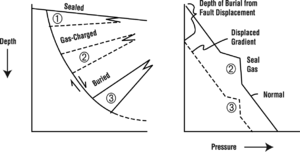Pressure prediction: reconstructing burial history
| It has been suggested that this article be merged with [[::Pressure prediction|Pressure prediction]]. (Discuss) |
| Exploring for Oil and Gas Traps | |

| |
| Series | Treatise in Petroleum Geology |
|---|---|
| Part | Critical elements of the petroleum system |
| Chapter | Formation fluid pressure and its application |
| Author | Edward A. Beaumont, Forrest Fiedler |
| Link | Web page |
| Store | AAPG Store |
Reconstructing the burial history of a play area gives an estimate of vertical displacement by either burial or faulting of at least an order of magnitude of measurement. A pressure-depth plot, using the estimate of vertical displacement and normal fluid gradients, helps reveal the magnitude of the pressure abnormality that might be present if seals were in place at the appropriate time to trap the abnormal pressure.
Procedure: predicting fluid pressure
To predict the fluid pressure of a sealed container using burial history analysis, use the procedure outlined below.
- Plot the normal pressure gradient that existed when the container was sealed.
- Plot the present gradient, adding the new depth of burial.
Example
In the case of a sand body carried deeper by a growth fault, first plot the normal gradients that would have existed prior to burial; then replot the gradients at the existing depth.
The diagrams in Figure 1 illustrate burial stages 1, 2, and 3 and the corresponding pressure-depth relationships.
Using normal pressure gradient
Use of normal pressure gradients only gives an approximation for estimating pressure in a burial history analysis. It is difficult, if not impossible, to be more precise because there are so many other unknowns, such as pressure and temperature at the charging stage, molecular composition of the fluids, effectiveness of seals, and original and current temperatures.
See also
- Abnormal hydrostatic pressure
- Abnormal pressure prediction
- Normal hydrostatic pressure gradients
- Pressure prediction: analysis of mud weights
- Pressure prediction: analysis of cuttings
- Pressure prediction: analysis of well-log and seismic data
